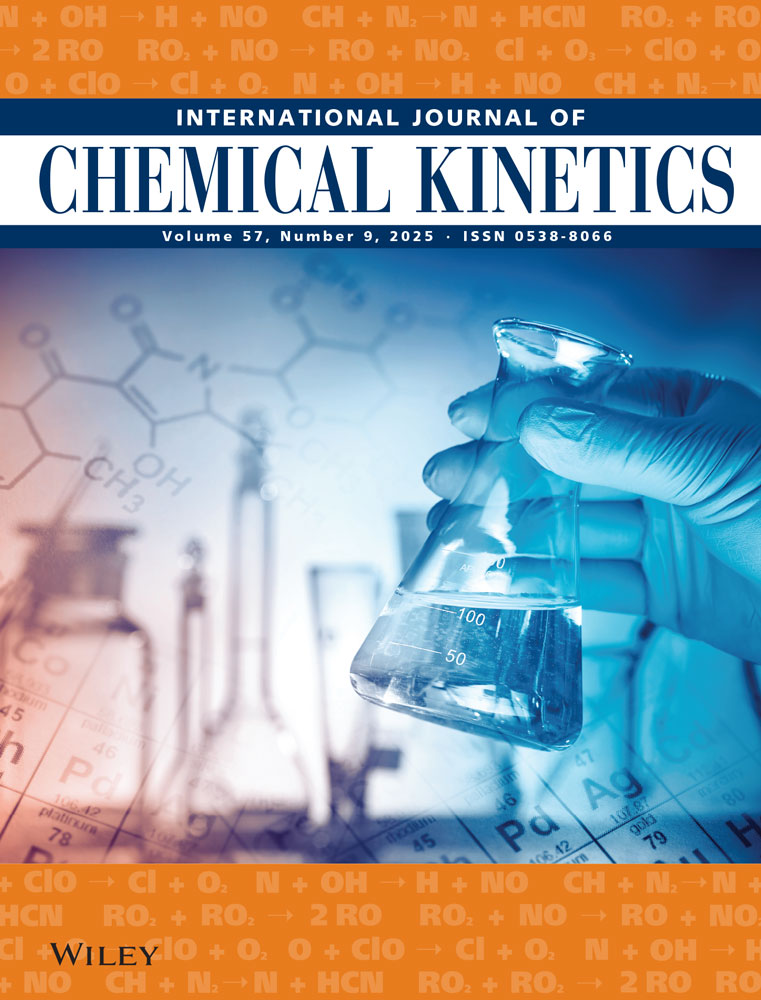Kinetics and mechanism of the oxidation of some α-hydroxy acids by 2,2′-bipyridinium chlorochromate
Vinita Kumbhat
Department of Chemistry, J. N. V. University, Jodhpur 342 005, Rajasthan, India
Search for more papers by this authorPradeep K. Sharma
Department of Chemistry, J. N. V. University, Jodhpur 342 005, Rajasthan, India
Search for more papers by this authorCorresponding Author
Kalyan K. Banerji
Department of Chemistry, J. N. V. University, Jodhpur 342 005, Rajasthan, India
Department of Chemistry, J. N. V. University, Jodhpur 342 005, Rajasthan, IndiaSearch for more papers by this authorVinita Kumbhat
Department of Chemistry, J. N. V. University, Jodhpur 342 005, Rajasthan, India
Search for more papers by this authorPradeep K. Sharma
Department of Chemistry, J. N. V. University, Jodhpur 342 005, Rajasthan, India
Search for more papers by this authorCorresponding Author
Kalyan K. Banerji
Department of Chemistry, J. N. V. University, Jodhpur 342 005, Rajasthan, India
Department of Chemistry, J. N. V. University, Jodhpur 342 005, Rajasthan, IndiaSearch for more papers by this authorAbstract
The oxidation of glycolic, lactic, malic, and a few substituted mandelic acids by 2,2′-bipyridinium chlorochromate (BPCC) in dimethylsulphoxide leads to the formation of corresponding oxoacids. The reaction is first order each in BPCC and the hydroxy acids. The reaction is catalyzed by the hydrogen ions. The hydrogen ion dependence has the form: kobs = a + b [H+]. The oxidation of α-deuteriomandelic acid exhibited a substantial primary kinetic isotope effect (kH/kd = 5.29 at 303 K). Oxidation of p-methylmandelic acid was studied in 19 different organic solvents. The solvent effect has been analyzed by using Kamlet's and Swain's multiparametric equations. A mechanism involving a hydride ion transfer via a chromate ester is proposed. © 2002 Wiley Periodicals, Inc. Int J Chem Kinet 34: 248–254, 2002
BIBLIOGRAPHY
- 1 Guziec, F. S.; Luzio, F. A. Synthesis 1980, 691.
- 2 Rathore, S.; Sharma, P. K.; Banerji, K. K. J Chem Res, Synop 1994, 298; J Chem Res, Miniprint 1994, 1636.
- 3 Rathore, S.; Sharma, P. K.; Banerji, K. K. Indian J Chem, Sect B 1995, 34, 702.
- 4 Loonkar, K.; Sharma, P. K.; Banerji, K. K. J Chem Res, Synop 1997, 242; J Chem Res, Miniprint 1997, 1663.
- 5 Loonkar, K.; Sharma, P. K.; Banerji, K. K. J Chem Res, Synop 1998, 66; J Chem Res, Miniprint 1998, 0457.
- 6 Asopa, R.; Bhatt, P.; Banerji, K. K. Indian J Chem, Sect A 1992, 31, 706.
- 7 Dave, I.; Sharma, V.; Banerji, K. K. Indian J Chem, Sect A 2000, 39, 728.
- 8 Banerji, K. K. J Chem Res, Synop 1978, 193; J Chem Res, Miniprint 1978, 2561.
- 9 Levesley, P.; Waters, W. A. J Chem Soc 1955, 215.
- 10 Vogel, A. I. A Text Book of Practical Organic Chemistry; Longmans: London, 1956; p. 776.
- 11 Kemp, T. J.; Waters, W. A. J Chem Soc 1964, 1192.
- 12 Perrin, D. D.; Armarego, W. L.; Perrin, D. R. Purification of Organic Compounds; Pergamon Press: Oxford, 1966.
- 13 Khanchandani, R.; Sharma, P. K.; Banerji, K. K. J Chem Res, Synop 1995, 432; J Chem Res, Miniprint 1995, 2622.
- 14 Loonkar, K.; Sharma, P. K.; Banerji, K. K. J Chem Res, Synop 1997, 242; J Chem Res, Miniprint 1997, 1663.
- 15(a) Laffler, J. E. J Org Chem 1955, 20, 1202; (b) Laffler, J. E. J Phys Chem 1964, 29, 2199.
- 16 Patterson, R. C. J Org Chem 1964, 29, 3133.
- 17 Exner, O. Collect Chem Czech Commun 1964, 29, 1094.
- 18 Kamlet, M. J.; Abboud, J. L. M.; Abraham, M. H.; Taft, R. W. J Org Chem 1983, 48, 2877 and references cited therein.
- 19 Exner, O. Collect Czech Chem Commun 1966, 31, 3222.
- 20 Swain, C. G.; Swain, M. S.; Powel, A. L.; Alunni, S. J Am Chem Soc 1983, 105, 502.
- 21 Brown, H. C.; Okamoto, Y. J Am Chem Soc 1958, 80, 4079.
- 22 Kwart, H.; Nickel, J. H. J Am Chem Soc 1973, 95, 3394.
- 23 Kwart, H.; Latimer, M. C. J Am Chem Soc 1971, 93, 3770.
- 24 Kwart, H.; Slutsky, J. J Chem Soc, Chem Commun 1972, 1182.
- 25 Loonker, K.; Sharma, P. K.; Banerji, K. K. J Chem Res, Synop 1997, 242; J Chem Res, Miniprint 1997, 1663.
- 26 Bordwell, F. G. Acc Chem Res 1974, 5, 374.
- 27 Woodward, R. W.; Hoffmann, R. Angew Chem Int Ed Eng 1969, 8, 781.
- 28 Litller, J. S. Tetrahedron 1971, 27, 81.
- 29(a) Perez-Benito, J. F.; Arias, C.; Lamrhari, D. J Chem Soc, Chem Commun 1992, 472; (b) Perez-Benito, J. F.; Arias, C. Can J Chem 1993, 71, 649.
- 30 Bhattacharjee, M. N.; Choudhary, M. K.; Purukayastha, S. Tetrahedron 1987, 43, 5389.
- 31 Brown, H. C.; Rao, C. G.; Kulkarni, S. U. J Org Chem 1979, 44, 2809.
- 32 Gould, E. S. Mechanism and Structure in Organic Chemistry; Holt, Rinehart, & Winston: New York, 1964.




